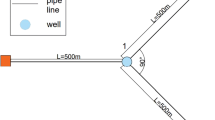Abstract
In the present paper, an analytical solution has been reached for determining the optimum pumping rate in a pipe network supplied from a ground water source by means of water wells. The solution depends on the use of the gradient technique which requires the derivatives of the studied cost functions and is based on the maximum economic benefit from the produced water. The solution is examined on a predetermined optimal water distribution system, and gives values for optimum pumping rates which are in good agreement with those obtained using the graphical solutions, indicating the reliability of the analytical solution. The effect of the initial cost on the optimum pumping rate and its bearing on the unit price of water has been also studied. This reflects the importance of choosing the proper unit water price that makes the water return covers the global cost and satisfies the maximum economic benefit from the produced water. Studying the effect of unit price of water on the water return or different pumping rates shows that, whether ignoring or including the initial cost, the water return increases with increase of pumping rate till reaching a turning point, often which the water return begin to drop slightly. Hence, this point determines the optimum pumping rate in the pipe network as well as the maximum economic benefit satisfied. Finally within the scope of the present study, it is concluded that, the identity or good agreement found in the results of optimum pumping rates, indicates the validity of the developed analytical solution and the employed graphical solutions.
Similar content being viewed by others
References
Bear, J. (1979). Hydraulics of groundwater, McGraw-Hill, New York, pp.1–81.
Bouwer, H. (1978). Groundwater hydrology, McGraw-Hill, New York.
Calborn, B. J. and Rainwater, K. A. (1991). “Well-field management for energy efficiency.” Journal of Hydrology Engineering, ASCE, Vol. 117, No. 10, pp. 1290–1303.
Darwich, M. R. (1982). Proposed methods for water pricing and charging in egypt, MSc Thesis, International Center for Advanced Mediterranean Agronomic Studies, Bari, Italy.
Egyptian Code of Practice and Specification (101-1997) for designed water and sewerage, Egypt.
Featherstone, R. E. and El-Jumaily, K. K. (1983). “Optimal diameter selection for pipe networks.” Journal of Hydrology Engineering, ASCE, Vol. 109, No. 2, pp. 221–234.
Fetter, C. W. (1994). Applied hydrogeology, Prentice Hall, New York.
Naggar, O. M. (2002). “Groundwater production cost.” Proceedings of the International Water Technology Conference, Cairo, Egypt.
Naggar, O. M. (2005). “Optimum design and construction of water wells.” 9 th Proceedings of the International Water Technology Conference, Sharm El-Sheikh, Egypt.
Rajput, R. K. (1998). A textbook of fluid mechanics, Rajendra Ravindra, New Delhi, India.
Somaida, M. M. (1991). “Analytical solutions for determining economically optimum well discharge.” Port Said, Science Engineering Bulletin, Vol. 3, No. 1, pp. 16–24.
Somaida, M. M. (1993). “Effects of the hydraulic and cost parameters on the economically optimum well discharge.” Port Said, Science Engineering Bulletin, Vol. 5, No. 1, pp. 25–34.
Somaida, M. M., Elzahar, M. M., and Sharaan, M. S. (2011). “The use of computer simulation and analytical solutions for optimal design of pipe networks supplied from a pumped groundwater source.” Port-Said Engineering Journal, August, 2011 (Accepted to be published).
Suez Canal University, Faculty of Engineering (2005). Hydraulic project, Civil Engineering Department, Suez Canal University, Ismailia, Egypt.
Tung, Y. K. (1986). “Ground water management by chance-constrained model.” J. Water Resources Planning and Management, ASCE, Vol. 112, No. 1, pp. 1–19. http://www.epa.gov/ORD/NRMRL/wswrd/epanet.html (Rossman 1994, http://www.epa.gov).
Author information
Authors and Affiliations
Corresponding author
Rights and permissions
About this article
Cite this article
Somaida, M.M., El-Zahar, M.M.H., Hamed, Y.A. et al. Optimizing pumping rate in pipe networks supplied by groundwater sources. KSCE J Civ Eng 17, 1179–1187 (2013). https://doi.org/10.1007/s12205-013-0116-4
Received:
Revised:
Accepted:
Published:
Issue Date:
DOI: https://doi.org/10.1007/s12205-013-0116-4




